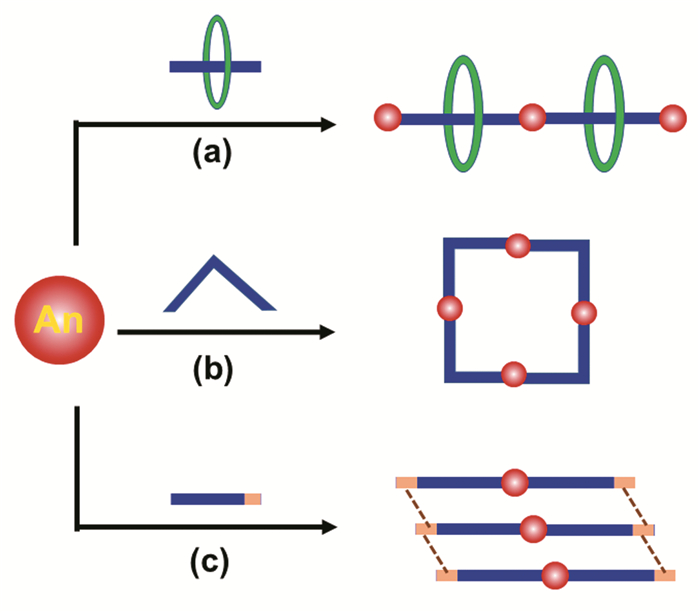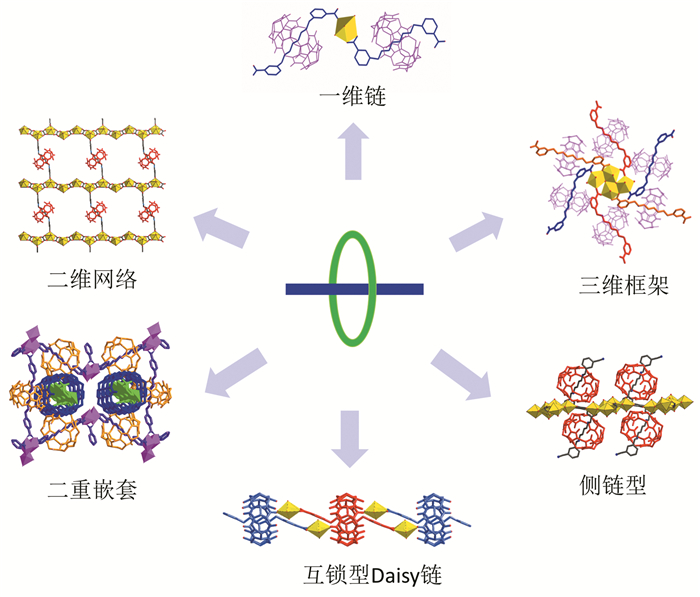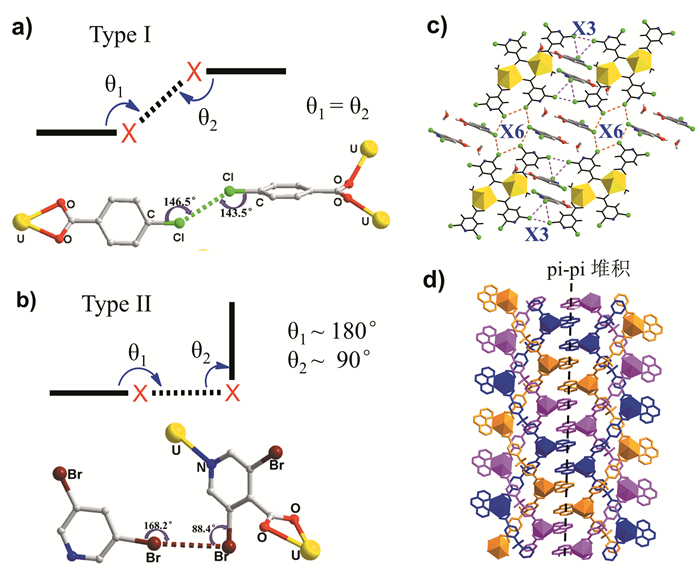Citation:
Mei Lei, Shi Weiqun. Construction Principles and Research Progress of Typical Actinide Supramolecular Assemblies[J]. Chemistry,
;2020, 83(5): 387-393.

-
Actinide supermolecular chemistry is one of the recently emerging research areas of actinide chemistry, which can provide important information for the basic research of coordination chemistry of spent fuel reprocessing, and also explore the function and potential application of actinide functional materials in the fields of luminescence, catalysis, separation et al. This review will introduce recent progresses in actinide-based supramolecular assemblies. Starting from the construction principle of actinide-based supramolecular assemblies, and in combination with the author's own research works, the progresses of three typical kinds of actinide supramolecular assemblies including actinide-rotaxane complexes based on host-guest rotaxane ligands, actinide coordination complexes with closed structures and actinide supramolecular polymers based on supramolecular interactions are reviewed and summarized. We hope the paper can provide a reference for the design and synthesis of new actinide-based supramolecular assemblies in the future and promote the development of related fields of actinide chemistry and mateirals.
-

-
- [1]
- [2]
- [3]
- [4]
- [5]
-
[6]
Gokel G W, Leevy W M, Weber M E. Chem. Rev., 2004, 104(5): 2723~2750.
- [7]
-
[8]
Zhang Y J, Bhadbhade M, Avdeev M, et al. Inorg. Chem., 2018, 57(14): 8588~8598.
-
[9]
Zhang Y, Lu K, Liu M, et al. Dalton Transac., 2020, 49(2): 404~410.
-
[10]
An S, Mei L, Hu K, et al. Inorg. Chem., 2020, 59(1): 943~955.
-
[11]
Mei L, Wu Q Y, Liu C M, et al. Chem. Commun., 2014, 50(27): 3612~3615.
-
[12]
Mei L, Xie Z N, Hu K Q, et al. Dalton Transac., 2016, 45(34): 13304~13307.
-
[13]
Mei L, Wu Q Y, Yuan L Y, et al. Chem. Eur. J., 2016, 22(32): 11329~11338.
-
[14]
Mei L, Wang L, Liu C M, et al. Chem. Eur. J., 2015, 21(28): 10226~10235.
-
[15]
Li F Z, Mei L, Hu K Q, et al. Inorg. Chem., 2018, 57(21): 13513~13523.
-
[16]
Mei L, Xie Z N, Hu K Q, et al. Chem. Eur. J., 2017, 23(56): 13995~14003.
-
[17]
Z N Xie, Mei L, Q Y Wu, et al. Dalton Transac., 2017, 46(23): 7392~7396.
-
[18]
Ge Y C, Mei L, Xie Z N, et al. Chem. Eur. J., 2017, 23(35): 8380~8384.
-
[19]
Xie Z N, Mei L, Hu K Q, et al. Inorg. Chem., 2017, 56(6): 3227~3237.
-
[20]
Thuery P, Villiers C, Jaud J, et al. J. Am. Chem. Soc., 2004, 126(22): 6838~6839.
-
[21]
Pasquale S, Sattin S, Escudero-Adan E C, et al. Nat. Commun., 2012, 3: 785.
-
[22]
Krivovichev S V, Kahlenberg V, Tananaev I G, et al. J. Am. Chem. Soc., 2005, 127(4): 1072~1073.
-
[23]
Krivovichev S V, Kahlenberg V, Kaindl R, et al. Angew. Chem. Int. Ed., 2005, 44(7): 1134~1136.
- [24]
-
[25]
Mihalcea I, Henry N, Loiseau T. Cryst. Growth Des., 2011, 11(5): 1940~1947.
-
[26]
Burns P C, Kubatko K A, Sigmon G, et al. Angew. Chem. Int. Ed., 2005, 44(14): 2135~2139.
- [27]
-
[28]
Sigmon G E, Unruh D K, Ling J, et al. Angew. Chem. Int. Ed., 2009, 48(15): 2737~2740.
-
[29]
Soderholm L, Almond P M, Skanthakumar S, et al. Angew. Chem. Int. Ed., 2008, 47(2): 298~302.
-
[30]
Falaise C, Volkringer C, Vigier J F, et al. J. Am. Chem. Soc., 2013, 135(42): 15678~15681.
-
[31]
Albrecht-Schmitt T E. Angew. Chem. Int. Ed., 2005, 44(31): 4836~4838.
-
[32]
Andrews M B, Cahill C L. Chem. Rev., 2013, 113(2): 1121~1136.
-
[33]
Serezhkin V N, Grigoriev M S, Savchenkov A V, et al. Inorg. Chem., 2019, 58(21): 14577~14585.
-
[34]
Surbella R G, Ducati L C, Autschbach J, et al. Inorg. Chem., 2018, 57(5): 2455~2471.
-
[35]
Andrews M B, Cahill C L. Dalton Transac., 2012, 41(14): 3911~3914.
-
[36]
Mei L, Wang C Z, Wang L, et al. Cryst. Growth Des., 2015, 15(3): 1395~1406.
-
[37]
Mei L, Wu Q Y, An S W, et al. Inorg. Chem., 2015, 54(22): 10934~10945.
-
[38]
An S W, Mei L, Wang C Z, et al. Chem. Commun., 2015, 51(43): 8978~8981.
-
[39]
Mei L, Liu K, Wu S, et al. Chem. Eur. J., 2019, 25(44): 10309~10313.
-
[40]
Carter K P, Kalaj M, Cahill C L. Eur. J. Inorg. Chem., 2016, (1): 126~137.
-

-
-
[1]
Huiying Xu , Minghui Liang , Zhi Zhou , Hui Gao , Wei Yi . Application of Quantum Chemistry Computation and Visual Analysis in Teaching of Weak Interactions. University Chemistry, 2025, 40(3): 199-205. doi: 10.12461/PKU.DXHX202407011
-
[2]
Ming Li , Zhaoyin Li , Mengzhu Liu , Shaoxiang Luo . Unveiling the Artistry of Mordant Dyeing: The Coordination Chemistry Beneath. University Chemistry, 2024, 39(5): 258-265. doi: 10.3866/PKU.DXHX202311085
-
[3]
Chengtian Liang , Boyuan Zheng , Ning Fang . 第38届中国化学奥林匹克(初赛)配位化学试题解析. University Chemistry, 2025, 40(8): 394-400. doi: 10.12461/PKU.DXHX202410054
-
[4]
Jiayao Wang , Guixu Pan , Ning Wang , Shihan Wang , Yaolin Zhu , Yunfeng Li . Preparation of donor-π-acceptor type graphitic carbon nitride photocatalytic systems via molecular level regulation for high-efficient H2O2 production. Acta Physico-Chimica Sinica, 2025, 41(12): 100168-0. doi: 10.1016/j.actphy.2025.100168
-
[5]
Keweiyang Zhang , Zihan Fan , Liyuan Xiao , Haitao Long , Jing Jing . Unveiling Crystal Field Theory: Preparation, Characterization, and Performance Assessment of Nickel Macrocyclic Complexes. University Chemistry, 2024, 39(5): 163-171. doi: 10.3866/PKU.DXHX202310084
-
[6]
Jiaxun Wu , Mingde Li , Li Dang . The R eaction of Metal Selenium Complexes with Olefins as a Tutorial Case Study for Analyzing Molecular Orbital Interaction Modes. University Chemistry, 2025, 40(3): 108-115. doi: 10.12461/PKU.DXHX202405098
-
[7]
Yukun CHEN , Kexin FENG , Bolun ZHANG , Wentao SONG , Jianjun ZHANG . Syntheses, crystal structures, and diametrically opposed mechanically-stimulated luminescence response of two Mg(Ⅱ) metal-organic frameworks. Chinese Journal of Inorganic Chemistry, 2025, 41(6): 1227-1234. doi: 10.11862/CJIC.20240448
-
[8]
Yuxin CHEN , Yanni LING , Yuqing YAO , Keyi WANG , Linna LI , Xin ZHANG , Qin WANG , Hongdao LI , Wenmin WANG . Construction, structures, and interaction with DNA of two SmⅢ4 complexes. Chinese Journal of Inorganic Chemistry, 2025, 41(6): 1141-1150. doi: 10.11862/CJIC.20240258
-
[9]
Quanguo Zhai , Peng Zhang , Wenyu Yuan , Ying Wang , Shu'ni Li , Mancheng Hu , Shengli Gao . Reconstructing the “Fundamentals of Coordination Chemistry” in Inorganic Chemistry Course. University Chemistry, 2024, 39(11): 117-130. doi: 10.12461/PKU.DXHX202403065
-
[10]
Cen Zhou , Biqiong Hong , Yiting Chen . Application of Electrochemical Techniques in Supramolecular Chemistry. University Chemistry, 2025, 40(3): 308-317. doi: 10.12461/PKU.DXHX202406086
-
[11]
Hailian Tang , Siyuan Chen , Qiaoyun Liu , Guoyi Bai , Botao Qiao , Liu Fei . Stabilized Rh/hydroxyapatite Catalyst for Furfuryl Alcohol Hydrogenation: Application of Oxidative Strong Metal-Support Interactions in Reducing Conditions. Acta Physico-Chimica Sinica, 2025, 41(4): 2408004-0. doi: 10.3866/PKU.WHXB202408004
-
[12]
Renjie Xue , Chao Ma , Jing He , Xuechao Li , Yanning Tang , Lifeng Chi , Haiming Zhang . Catassembly in the Host-Guest Recognition of 2D Metastable Self-Assembled Networks. Acta Physico-Chimica Sinica, 2024, 40(9): 2309011-0. doi: 10.3866/PKU.WHXB202309011
-
[13]
Jia Yao , Xiaogang Peng . Theory of Macroscopic Molecular Systems: Theoretical Framework of the Physical Chemistry Course in the Chemistry “101 Plan”. University Chemistry, 2024, 39(10): 27-37. doi: 10.12461/PKU.DXHX202408117
-
[14]
Xiangli Wang , Yuanfu Deng . Teaching Design of Elemental Chemistry from the Perspective of “Curriculum Ideology and Politics”: Taking Arsenic as an Example. University Chemistry, 2024, 39(2): 270-279. doi: 10.3866/PKU.DXHX202308092
-
[15]
Linhan Tian , Changsheng Lu . Discussion on Sextuple Bonding in Diatomic Motifs of Chromium Family Elements. University Chemistry, 2024, 39(8): 395-402. doi: 10.3866/PKU.DXHX202401056
-
[16]
Wen Jiang , Jieli Lin , Zhongshu Li . 低配位含磷官能团的研究进展. University Chemistry, 2025, 40(8): 138-151. doi: 10.12461/PKU.DXHX202409144
-
[17]
Shihui Shi , Haoyu Li , Shaojie Han , Yifan Yao , Siqi Liu . Regioselectively Synthesis of Halogenated Arenes via Self-Assembly and Synergistic Catalysis Strategy. University Chemistry, 2024, 39(5): 336-344. doi: 10.3866/PKU.DXHX202312002
-
[18]
Wenjian Zhang , Mengxin Fan , Wenwen Fei , Wei Bai . Cultivation of Critical Thinking Ability: Based on RAFT Polymerization-Induced Self-Assembly. University Chemistry, 2025, 40(4): 108-112. doi: 10.12461/PKU.DXHX202406099
-
[19]
Rui Li , Jiayu Zhang , Anyang Li . Two Levels of Understanding of Chemical Bonds: a Case of the Bonding Model of Hypervalent Molecules. University Chemistry, 2024, 39(2): 392-398. doi: 10.3866/PKU.DXHX202308051
-
[20]
Hao XU , Ruopeng LI , Peixia YANG , Anmin LIU , Jie BAI . Regulation mechanism of halogen axial coordination atoms on the oxygen reduction activity of Fe-N4 site: A density functional theory study. Chinese Journal of Inorganic Chemistry, 2025, 41(4): 695-701. doi: 10.11862/CJIC.20240302
-
[1]
Metrics
- PDF Downloads(13)
- Abstract views(1255)
- HTML views(303)

 Login In
Login In





 DownLoad:
DownLoad:


